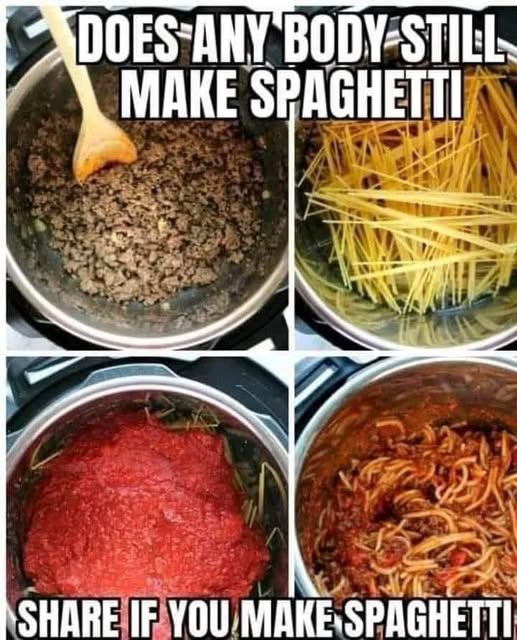Old-School Spaghetti: A Classic Comfort Dish That Never Goes Out of Style 🍝
There are few meals as iconic and soul-satisfying as Old-School Spaghetti. It’s a dish steeped in tradition, rich in flavor, and simple in its execution. This timeless classic brings together generations around the dinner table, combining slow-simmered meat sauce, perfectly cooked spaghetti, and the unmistakable aromas of garlic, herbs, and tomatoes.
In a world of modern twists and culinary trends, sometimes the best meal is the one that reminds us of home — warm, hearty, and made with love.
The Heartwarming History of Old-School Spaghetti
Old-school spaghetti is more than a recipe — it’s a cultural staple, especially within Italian-American households. Though it takes inspiration from Italy’s traditional ragù alla bolognese, this version was born from adaptation and necessity.
Italian immigrants arriving in the U.S. in the early 20th century used affordable American ingredients to recreate the flavors of home. The result? A distinctly Americanized version of pasta with meat sauce that quickly became a go-to family dinner. It’s nostalgic, comforting, and deeply rooted in the belief that food brings people together.
Essential Ingredients for Authentic Old-School Flavor
The beauty of old-school spaghetti lies in its simple, pantry-friendly ingredients that deliver bold, hearty flavor:
- 1 tablespoon olive oil
- 1 pound ground beef (or a mix of beef and pork for added depth)
- 1 small onion, finely chopped
- 2 cloves garlic, minced
- 1 can (28 oz) crushed tomatoes
- 2 tablespoons tomato paste
- 1 teaspoon dried oregano
- 1 teaspoon dried basil
- 1/2 teaspoon salt
- 1/2 teaspoon black pepper
- 1/2 teaspoon sugar (optional — helps balance acidity)
- 1/4 teaspoon red pepper flakes (optional for a gentle kick)
- 1/2 cup water or beef broth
- 12 ounces spaghetti noodles
- Freshly grated Parmesan cheese and chopped parsley, for garnisht
Optional Additions for Elevated Flavor
- A splash of red wine during the browning process
- Italian sausage for a bolder, savory taste
- Sautéed mushrooms, carrots, or bell peppers for added texture and nutrition
- A bay leaf to infuse depth (be sure to remove before serving)
- A few tablespoons of grated Parmesan stirred into the sauce
Step-by-Step Cooking Instructions
1. Sauté and Brown the Meat
Start by heating the olive oil in a large skillet or saucepan over medium heat. Add the ground beef and cook until deeply browned, breaking it up with a wooden spoon as it cooks. Browning adds essential richness — don’t rush it.
2. Add Aromatics
Stir in the chopped onion and minced garlic. Sauté for 3–4 minutes until soft and fragrant.
3. Build the Sauce
Add the crushed tomatoes, tomato paste, broth or water, and all seasonings (oregano, basil, salt, pepper, sugar, red pepper flakes). Stir well to combine.
4. Simmer Low and Slow
Reduce the heat to low and partially cover the pan. Let the sauce simmer for 30–45 minutes, stirring occasionally. This allows flavors to meld and develop.
5. Cook the Pasta
Meanwhile, bring a large pot of well-salted water to a boil. Cook the spaghetti noodles according to package directions until al dente. Drain, reserving a little pasta water.
6. Combine and Serve
You can either toss the pasta with the sauce in the pot for full coating, or ladle the sauce generously over individual plates of spaghetti. Top with Parmesan cheese and a sprinkle of fresh parsley.
Tips for the Best Old-School Spaghetti
- Salt the pasta water generously; it’s your first layer of seasoning.
- Use freshly grated cheese — pre-grated varieties can have additives that impact melt and taste.
- Don’t skip the simmer — the longer it cooks, the richer the flavor.
- Reserve pasta water to help thin the sauce and make it cling beautifully to the noodles.
- Make extra! This dish tastes even better the next day as flavors continue to deepen.
Serving Suggestions That Complete the Meal
- Garlic Bread: Toasted, buttery, and perfect for scooping up every last bit of sauce.
- Crisp Green Salad: Balances the richness of the pasta with freshness and crunch.
- Red Wine: A glass of Chianti or Sangiovese complements the tomato and meat flavors perfectly.
Health-Conscious Variations for a Modern Twist
You can keep the flavor and nostalgia intact while making a few healthy swaps:
- Use whole wheat or legume-based pasta for added fiber and protein.
- Substitute lean ground turkey or chicken for a lighter option.
- Load the sauce with extra vegetables like zucchini, spinach, or mushrooms.
- Reduce the amount of oil and cheese for a lower-fat version.
- Try zoodles (zucchini noodles) to make it low-carb while still satisfying.
Old-School Spaghetti Casserole Variation
Got leftovers? Turn them into an easy baked spaghetti casserole:
- Layer cooked spaghetti and meat sauce in a baking dish.
- Sprinkle with shredded mozzarella and Parmesan.
- Bake at 375°F (190°C) for 20–25 minutes until bubbly and golden.
It’s a fantastic way to stretch leftovers into another delicious meal.
Nutrition Facts (Approx. per serving, serves 6)
- Calories: 420
- Fat: 16g
- Saturated Fat: 6g
- Carbohydrates: 47g
- Fiber: 4g
- Sugars: 7g
- Protein: 22g
Note: Values will vary based on ingredients used and optional additions.
Why We’ll Always Love Old-School Spaghetti
There’s something deeply comforting about a dish that’s been passed down from generation to generation. Old-School Spaghetti captures the essence of family, tradition, and home-cooked goodness. It’s not about being fancy—it’s about being real, honest, and satisfying. From the savory aroma that fills your kitchen to the last forkful on your plate, this dish is a celebration of simplicity done right.
Whether you’re feeding a crowd, cooking for two, or prepping for the week ahead, this is one recipe that never goes out of style.
